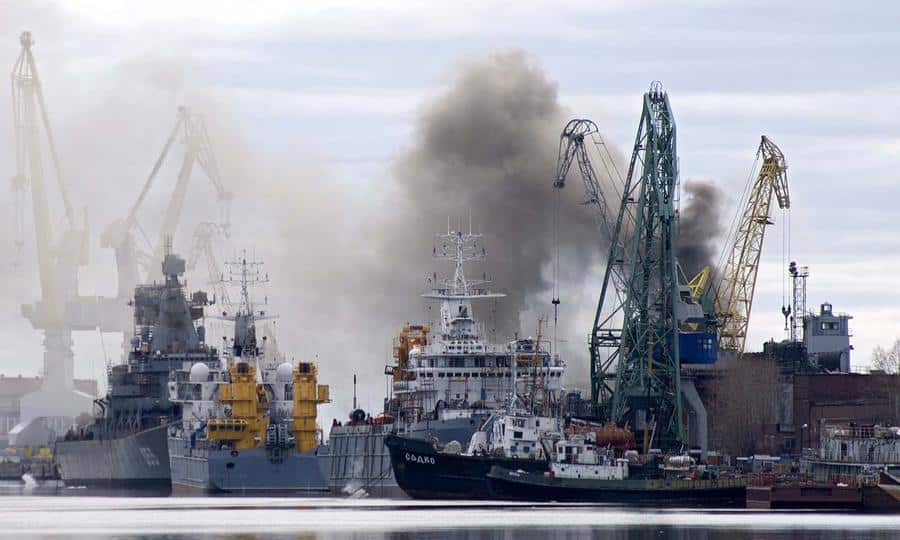Some sort of Russian rocket engine exploded in Nyonoksa, a naval test area near the city of Severodvinsk. The Russians have been closed-mouthed about the kind of rocket test that took place, but subsequently, a large section of the White Sea area around the Nyonoksa test range has been closed off to shipping for at least 30 days.
Meanwhile, local authorities in Severodvinsk ordered school children to be kept indoors and urged residents to use either liquid iodine or take iodine pills. One resident working in a local hospital confirmed they were drinking liquid iodine (non-radioactive potassium iodine), 44 drops per glass of water.
Potassium Iodine (in pill or liquid form) is used to fill up the thyroid gland with stable, non-radioactive iodine, thereby blocking radioactive iodine from getting into the thyroid where it can disrupt it and, presumably in cases of short term survival, cause cancer and other diseases. In the United States, a number of Federal agencies (even the Post Office) have been stockpiling millions of iodine pills. In some areas where there are nuclear reactors, state and local agencies also are stockpiling iodine pills. There also has been growing concern about a “dirty bomb” threat from terrorists. Moscow already had one such incident perpetrated by Chechen terrorists.
On the surface at least, a rocket test is inconsistent with a radiation leak, but there isn’t any doubt such a leak caused a spike in radiation to which local authorities responded. Officially, Russia initially denied there was any such leak.
There is a great deal of speculation on what caused the accident, but none of it based on any solid evidence. What has been seen are photos of First Responders (from the Russian Air Force) wearing Hazmat suits and evacuating wounded on Mi-8 helicopters.
According to The Guardian, Russia’s nuclear energy agency [Rosatom] has said an explosion that caused radiation levels to spike in the Arkhangelsk region was caused by an accident during a test of an “isotope power source for a liquid-fueled rocket engine.” In a statement released late on Friday, Rosatom said five of its employees had died as a result of the accident and three more were being treated for burns.”
Some have said that it could have been a submarine-related accident where a failed launch led to radioactive contamination. Russia would not launch a nuclear-equipped missile in any test as it would violate nuclear test agreements. There is no evidence that Russia has ever violated the ban on atmospheric testing, the 1963 Treaty Banning Nuclear Weapon Tests in the Atmosphere, in Outer Space and Under Water.
There are suggestions that the explosion was the result of an accident. The Drive has reported that in “September 1991, just months before the collapse of the Soviet Union, an R-39 Rif submarine-launched ballistic missile, thankfully with no live nuclear warheads inside, blew up inside its launch tube on the Typhoon class submarine TK-17 during a test.”
In that accident, the missiles had inert warheads – the real danger was the submarine could blow up, and its two power reactors could have caused a serious nuclear incident. In August 2000 the Kursk K-141 nuclear submarine, involved in tests of its Granit missiles and also torpedoes, exploded and sank, an accident that appears to have been caused by a torpedo that exploded during an attempted launch. Like the R-39, the Kursk disaster did not involve nuclear weapons.
In 2011 the Ekaterinburg, a Russian Delfin-class submarine, in drydock for modifications and repair, caught fire. On board the sub were 16 R-29 nuclear-armed ballistic missiles. The missiles did not explode and did not further damage the Ekaterinburg or the area around the drydock. Why the Russians would have nuclear-armed missiles on a sub undergoing repairs is an example of how reckless the Russians can be with nuclear technology.
Hypersonic missile test?
As to what was going on in Nyonoksa, there are various reports that say that a “missile” was being launched from a test barge and the rocket may have been the newest hypersonic missile in the Russian arsenal, the 3M22 Zircon (or Tsircon) hypersonic missile. The 3M22, according to President Vladimir Putin, is already in service with Russia’s Navy and will be fully operational in 2020 on two Kirov-class battlecruisers, the Admiral Nakhimov and Pyotr Velikiy.
There are two immediate problems with this supposition: the first is why would the Russians need to test the 3M22 if it is already in serial production? The second, and more important, is why would there be nuclear contamination associated with a 3M22 test, as the 3M22 is known to use a liquid fuel rocket booster for launch, and a scramjet engine for hypersonic propulsion. Liquid fueled rockets do not have any nuclear power source, and scramjet engines, which have no moving parts, use a standard combustion fuel plus an oxidizer.
By STEPHEN BRYEN, THE ASIA TIMES, READ FULL ARTICLE
A Russian Navy base near the site of the current accident. In the image, smoke rises from a dock where the Orel nuclear submarine was in for repairs at a shipyard in Severodvinsk in 2015. Photo: Oleg Kuleshov / AFP
Redazione
La redazione di Babilon è composta da giovani giornalisti, analisti e ricercatori attenti alle dinamiche mondiali. Il nostro obiettivo è rendere più comprensibile la geopolitica a tutti i tipi di lettori.
L’evoluzione dei sanitari a terra: design moderni e materiali innovativi per una scelta sempre più popolare
23 Dic 2024
Quando si parla di design di interni e arredamento sono tantissimi i fattori che entrano in gioco. Ciascuno di noi ha…
Se le questioni di genere dettano le agende di politica estera
19 Dic 2024
Il perseguimento di politiche identitarie da parte dell'establishment della politica estera occidentale sta portando a…
Dall’origine straniera all’icona americana: il fenomeno dello sport negli Usa
14 Mar 2024
Molti sport americani sono accomunati da un aspetto particolarmente curioso: raramente sono davvero nati sul suolo…
Roulette europea, francese o americana? Ecco un approfondimento
22 Set 2023
La roulette è un classico intramontabile dei casinò, amata da milioni di appassionati in tutto il mondo. Una delle…




